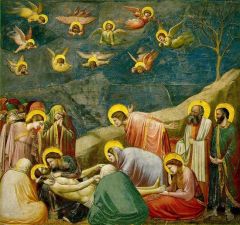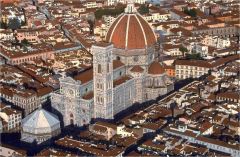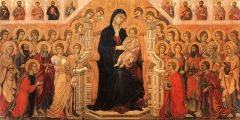![]()
![]()
![]()
Use LEFT and RIGHT arrow keys to navigate between flashcards;
Use UP and DOWN arrow keys to flip the card;
H to show hint;
A reads text to speech;
5 Cards in this Set
- Front
- Back
![Franceso Traini
"The Black Death" [The Triumph of Death]
Full Fresco 18'6" X 49'2"
1330's
It's a Tour de Force of death Imagery.
Fresco remains disputed.
Some attribute the work to Francesco Traini while others argue for Buonamico Buffalmacco.
Pa](https://images.cram.com/images/upload-flashcards/923096/598411_m.jpg)
Franceso Traini
"The Black Death" [The Triumph of Death] Full Fresco 18'6" X 49'2" 1330's It's a Tour de Force of death Imagery. Fresco remains disputed. Some attribute the work to Francesco Traini while others argue for Buonamico Buffalmacco. Painted on the wall in Pisa's Camposanto, the enclosed burial ground adjacent to the city's cathedral. The fresco captures the horrors of death. Forces the viewer to confront their mortality. Left foreground shows young aristocrats. Aristocrats are mounted in a stylish cavalcade whom encounter three coffin encased corpses in different stages of decay. As the horror of the confrontation with death strikes them, the ladies turn away with disgust. The men hold their noses. The dogs, horses, animals sniff excitedly. |
![Franceso Traini
"The Black Death" [Triumph of Death]
Full Fresco 18'6 X 49'2''
1330's
The men and woman ignore dreadful realities, occupying themselves in an orange grove with music and amusements.
The angels and demons struggle for the sole of th](https://images.cram.com/images/upload-flashcards/923096/598412_m.jpg)
Franceso Traini
"The Black Death" [Triumph of Death] Full Fresco 18'6 X 49'2'' 1330's The men and woman ignore dreadful realities, occupying themselves in an orange grove with music and amusements. The angels and demons struggle for the sole of the corpses heaped in the foreground. The painter depicted those who appear unprepared for death. Thus unlikely ready. Thus unready for salvation. |
|
![Cimabue
"Madonna Enthroned with Angel's and Prophets"
Tempura and gold lead on wood
1280-1290
Created for the church of Santa Trinita [Holy Trinity] in Florence
Shows the painters reliance on Byzantine models for the composition as well as the gold](https://images.cram.com/images/upload-flashcards/923096/598413_m.jpg)
Cimabue
"Madonna Enthroned with Angel's and Prophets" Tempura and gold lead on wood 1280-1290 Created for the church of Santa Trinita [Holy Trinity] in Florence Shows the painters reliance on Byzantine models for the composition as well as the gold background. Cimabue used gold embellishments on Madonna's robe. The gold on Madonna's robes enhances the dimensionality of her drapery. Artist used a great deal of Byzantine influences while creating "Madonna Enthroned with Angels and Prophets" The Virgin's throne appears to recede into space. The overlapping bodies looking up, or outward reinforce a sense of depth. The baby's body appears very awkward for a baby. |
![Giotto
"Madonna Enthroned The Chapel Arena"
Tempera and gold leaf on wood
1310
Depicting the same subject as Cimabue's.
Painted for the high altar of the Ognissanti [All Saints Church in Florence]
Seen against the traditional gold background.
Gio](https://images.cram.com/images/upload-flashcards/923096/598414_m.jpg)
Giotto
"Madonna Enthroned The Chapel Arena" Tempera and gold leaf on wood 1310 Depicting the same subject as Cimabue's. Painted for the high altar of the Ognissanti [All Saints Church in Florence] Seen against the traditional gold background. Giotto's's Madonna rests within her Gothic Throne. Giotto changed Cimabue's thin virgin with a heavier, and more motherly appearance. Giotto shows Mary's breast's pressing through the thin fabric of her white garments. Giotto's "Madonna Enthroned" marks the end of medieval painting in Italy and the beginning of another new approach to art. There was originally gold on the women's clothing. However it has faded with time. |
|

Giotto Di Bondone
"Lamination" Arena Chapel Fresco 1305 The artist used the diagonal slope of the rocky landscape to direct the viewers attention toward the head of the sculptures figure to the dead Christ. The Angels are seen head-on with their bodies receding into the back ground and darting about in hysterical grief. A congregation mourns over the dead body of the Savior just before its entombment. Mary cradles her son's body. Another women looks solemnly at the wounds in Christ's feet. Saint John throws his arms back dramatically. The ledge provides firm visual support for the figures. The steep slope indicates the pictures dramatic focal point at the lower left. The rocky setting recalls that of a 12th century Byzantine mural which also links this scene with the adjoining one. There is a great deal of grief shown. The dead tree is the tree of knowledge of good and evil, which withered at the fall of Adam. Giotto frequently shows people in the back. |

Arnolfo de Cambio and Others
Florence Cathedral Begun in 1296 It's recognized as the center for the most important religous observances in the city. The Cathedral authorities planned for the church to hold the city's entire population. It can hold 30,000 people. At the time Florence's population was slightly less than a 100,000. The builders ornameted the church's surfaces in the old Tuscan fashion. The marble encrusted geometric designs matched the cathedrals decorative wall paneling of the neighboring 11th century Romanesque baptistery of San Giovanni. |
|

Duccio Di Bouninsegna
"Virgin and Chold Enthorned with Saints" Tempera and gold leaf on wood 1308-1311 Replaced a much smaller painting of the Virgin Mary on the high alter of Siena Cathedral. Duccio had help with the piece. The piece consisted of a seven foot high central panel surmounted by seven pinnacles and a predella. Painted in temera front and back. The work is no longer viewable. The main panel of the front side represents the Virgin enthroned as Queen of Heaven amid choruses of angels and saints. Duccio derived the composition's formality and symmetry, along with the figures and facial types of the principalangels and saints, from Byzantine tradition. The figures turn to each other in quiet conversation. The four saints are individualized who perform their ceremonial gestures without stiffness. The woman's drapery falls and curves loosely. |

Lorenzetti Brothers
"Peaceful City from Good Government" Fresco 1338-1339 The artist depicted the urban and rural effects of good government. It's painted as an illusionistic panorama of the bustling city. The fresco was addressing the cities concerns. It's a paroramic view of Sienna's clustering palaces, markets, towers, churches streets and walls . It's reminiscent of the townscapes of ancient Roman murals. Dancers served as a metaphor for a peaceful commonwealth. The cities crowds move peacefully. You can see people trading. |
|
|
Fresco: is a technique of mural painting executed upon freshly laid lime plaster. Water is used as the vehicle for the pigment and, with the setting of the plaster, the painting becomes an integral part of the wall. The word fresco (Italian: affresco) is derived from the Italian adjective fresco meaning "fresh".
|
Tempera: Also known as egg tempera, is a permanent fast-drying painting medium consisting of colored pigment mixed with a water-soluble binder medium (usually a glutinous material such as egg yolk or some other size). Tempera also refers to the paintings done in this medium.
|

